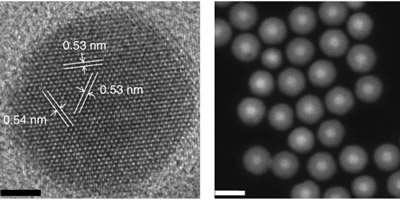
A research team of Foundry staff and users has demonstrated how light-emitting nanoparticles can be used to see deep in living tissue.
The specially designed nanoparticles can be excited by ultralow-power laser light at near-infrared wavelengths considered safe for the human body. They absorb this light and then emit visible light that can be measured by standard imaging equipment.
Researchers hope to further develop these so-called alloyed upconverting nanoparticles, or aUCNPs, so that they can attach to specific components of cells to serve in an advanced imaging system to light up even single cancer cells, for example. Such a system may ultimately guide high-precision surgeries and radiation treatments, and help to erase even very tiny traces of cancer.
For decades, the research community had believed that the best way to produce these so-called upconverting materials was to implant them or “dope” them with a low concentration of metals known as lanthanides. Too many of these metals, researchers had believed, would cause the light they emit to become less bright with more of these added metals.
But experiments led by Molecular Foundry researchers Bining “Bella” Tian and Angel Fernandez-Bravo, who made lanthanide-rich UCNPs and measured their properties, upended this prevailing understanding.
Studies of individual UCNPs proved especially valuable in showing that erbium, a lanthanide previously thought to only play a role in light emission, can also directly absorb light and free up another lanthanide, ytterbium, to absorb more light.
In this latest study, researchers have demonstrated how the aUCNPs can be imaged in live mouse tissue at several millimeters’ depth. They were excited with lasers weak enough not to cause any damage.
Researchers injected nanoparticles into the mammary fat pads of mice and recorded images of the light emitted by the particles, which did not appear to pose any toxicity to the cells.
More testing will be required to know whether the aUCNPs produced at Berkeley Lab can be safely injected into humans, and to test coatings Berkeley Lab scientists are designing to specifically bind to cancerous cells.
Future work at the Molecular Foundry will hopefully lead to improved techniques for imaging cancer using the aUCNPs, he said, and researchers are developing an imaging sensor to integrate with nanoparticles that could be attached to surgical equipment and even surgical gloves to pinpoint cancer hot spots during surgical procedures.

